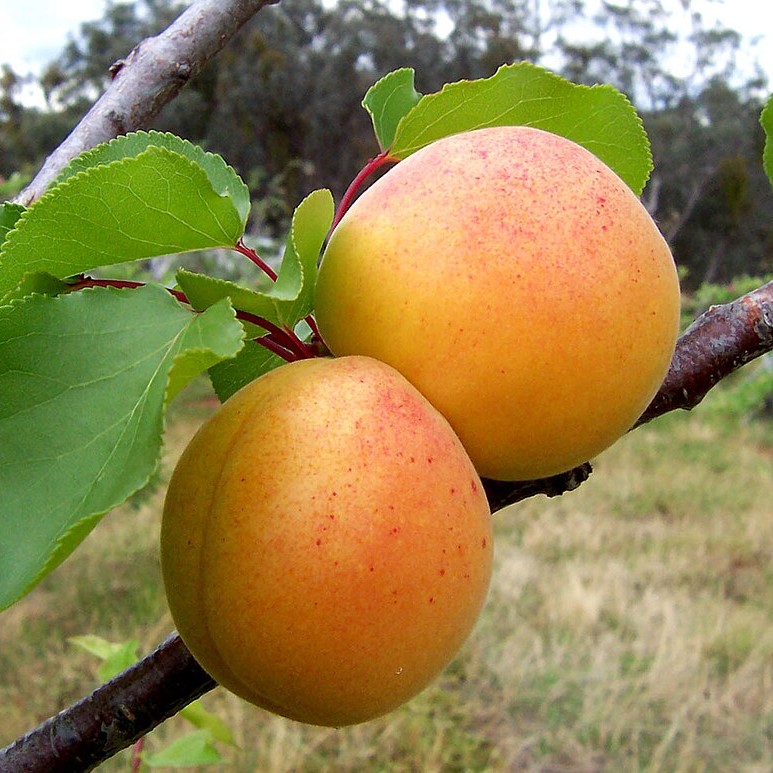Prunus armeniaca
Overview
| Genus | Prunus |
| Species | armeniaca |
| Common Name | Apricot |
| Abbreviation | P. armeniaca |
| Ploidy | Diploid |
| Chromosome Number | 2n = 2x = 16 |
| Genome Size | 230 Mb |
| Genome Assemblies | 9 |
| Cross Reference | NCBI taxon: 36596 |
Organism Image

Description
Prunus armeniaca is the most commonly cultivated apricot species. The native range is somewhat uncertain due to its extensive prehistoric cultivation. Genetic studies indicate Central Asia is the center of origin. It is extensively cultivated in many countries and has escaped into the wild in many places.
The specific epithet armeniaca refers to the country of Armenia in Western Asia.
Prunus armeniaca is a small tree, 8–12 m (26–39 ft) tall, with a trunk up to 40 cm (16 in) in diameter and a dense, spreading canopy. The leaves are ovate, 5–9 cm (2.0–3.5 in) long and 4–8 cm (1.6–3.1 in) wide, with a rounded base, a pointed tip and a finely serrated margin. The flowers are 2–4.5 cm (0.8–1.8 in) in diameter, with five white to pinkish petals; they are produced singly or in pairs in early spring before the leaves. The fruit is a drupe similar to a small peach, 1.5–2.5 cm (0.6–1.0 in) diameter (larger in some modern cultivars), from yellow to orange, often tinged red on the side most exposed to the sun; its surface can be smooth (botanically described as: glabrous) or velvety with very short hairs (botanically: pubescent). The flesh (mesocarp) is succulent and its taste can range from sweet to tart. The single seed is enclosed in a hard, stony shell, often called a "stone", with a grainy, smooth texture except for three ridges running down one side.
Whole Genomes
Whole Genome Sequences & Annotations for Prunus armeniaca
S genes
Prunus armeniaca Genome_v1.0 S genes
| Query | Chr | Size(bp) | Coordinates | Domain |
| ParSLF7.2 | LG1 | 24250751 | 20865952-20867421 | F-box; F_box_assoc |
| ParSLF7.1 | LG1 | 24250751 | 21200783-21202279 | F-box |
| ParSLF4 | LG1 | 24250751 | 21646081-21644714 | F-box; F_box_assoc |
| ParSLF9ψ | LG1 | 24250751 | 21707975-21709463 | - |
| ParSLF2 | LG1 | 24250751 | 21719117-21720445 | F-box; F_box_assoc |
| ParSFB | LG1 | 24250751 | 21748849-21749970 | F-box; F_box_assoc |
| ParSLF1 | LG1 | 24250751 | 21763367-21762138 | F-box; F_box_assoc |
| ParSLF3 | LG1 | 24250751 | 21782779-21784002 | F-box; F_box_assoc |
| ParSLF5 | LG1 | 24250751 | 21827408-21826230 | F-box; F_box_assoc |
| ParSLF8ψ | LG1 | 24250751 | 22043268-22042381 | - |
| ParSLF6 | LG1 | 24250751 | 23196566-23195367 | F-box; F_box_assoc |
| ParSLF10ψ | LG1 | 24250751 | 23684343-23685960 | - |
| S-RNase | LG1 | 24250751 | 21754247-21754172,21754003-21753819,21753650-21753216 | RNase_T2 |
Downloads
The Prunus armeniaca S gene sequences are available in FASTA format.
| CDS and Protein (FASTA file) | S-gene_Prunus_armeniaca |
Publications
Groppi A, Liu S, Cornille A, Decroocq S, Bui QT, Tricon D, Cruaud C, Arribat S, Belser C, Marande W, Salse J, Huneau C, Rodde N, Rhalloussi W, Cauet S, Istace B, Denis E, Carrère S, Audergon JM, Roch G, Lambert P, Zhebentyayeva T, Liu WS, Bouchez O, Lopez-Roques C, Serre RF, Debuchy R, Tran J, Wincker P, Chen X, Pétriacq P, Barre A, Nikolski M, Aury JM, Abbott AG, Giraud T, Decroocq V. Population genomics of apricots unravels domestication history and adaptive events. Nat Commun. 2021 Jun 25;12(1):3956. doi: 10.1038/s41467-021-24283-6.
Wang X, Liu S, Zuo H, Zheng W, Zhang S, Huang Y, Pingcuo G, Ying H, Zhao F, Li Y, Liu J, Yi TS, Zan Y, Larkin RM, Deng X, Zeng X, Xu Q. Genomic basis of high-altitude adaptation in Tibetan Prunus fruit trees. Curr Biol. 2021 Sep 13;31(17):3848-3860.e8. doi: 10.1016/j.cub.2021.06.062.
Tan Q, Li S, Zhang Y, Chen M, Wen B, Jiang S, Chen X, Fu X, Li D, Wu H, Wang Y, Xiao W, Li L. Chromosome-level genome assemblies of five Prunus species and genome-wide association studies for key agronomic traits in peach. Hortic Res. 2021 Oct 1;8(1):213. doi: 10.1038/s41438-021-00648-2.
Tang L, Liao X, Tembrock LR, Ge S, Wu Z. A chromosome-scale genome and transcriptomic analysis of the endangered tropical tree Vatica mangachapoi (Dipterocarpaceae). DNA Res. 2022 Feb 27;29(2):dsac005. doi: 10.1093/dnares/dsac005.
Campoy JA, Sun H, Goel M, Jiao WB, Folz-Donahue K, Wang N, Rubio M, Liu C, Kukat C, Ruiz D, Huettel B, Schneeberger K. Gamete binning: chromosome-level and haplotype-resolved genome assembly enabled by high-throughput single-cell sequencing of gamete genomes. Genome Biol. 2020 Dec 29;21(1):306. doi: 10.1186/s13059-020-02235-5.
Zhang Q, Zhang D, Yu K, Ji J, Liu N, Zhang Y, Xu M, Zhang YJ, Ma X, Liu S, Sun WH, Yu X, Hu W, Lan SR, Liu ZJ, Liu W. Frequent germplasm exchanges drive the high genetic diversity of Chinese-cultivated common apricot germplasm. Hortic Res. 2021 Oct 1;8(1):215. doi: 10.1038/s41438-021-00650-8.
Grimplet J. Genomic and Bioinformatic Resources for Perennial Fruit Species. Curr Genomics. 2022 Aug 11;23(4):217-233. doi: 10.2174/1389202923666220428102632.
Groppi A, Liu S, Cornille A, Decroocq S, Bui QT, Tricon D, Cruaud C, Arribat S, Belser C, Marande W, Salse J, Huneau C, Rodde N, Rhalloussi W, Cauet S, Istace B, Denis E, Carrère S, Audergon JM, Roch G, Lambert P, Zhebentyayeva T, Liu WS, Bouchez O, Lopez-Roques C, Serre RF, Debuchy R, Tran J, Wincker P, Chen X, Pétriacq P, Barre A, Nikolski M, Aury JM, Abbott AG, Giraud T, Decroocq V. Population genomics of apricots unravels domestication history and adaptive events. Nat Commun. 2021 Jun 25;12(1):3956. doi: 10.1038/s41467-021-24283-6.
Jiang F, Zhang J, Wang S, Yang L, Luo Y, Gao S, Zhang M, Wu S, Hu S, Sun H, Wang Y. The apricot (Prunus armeniaca L.) genome elucidates Rosaceae evolution and beta-carotenoid synthesis. Hortic Res. 2019 Nov 18;6:128. doi: 10.1038/s41438-019-0215-6.